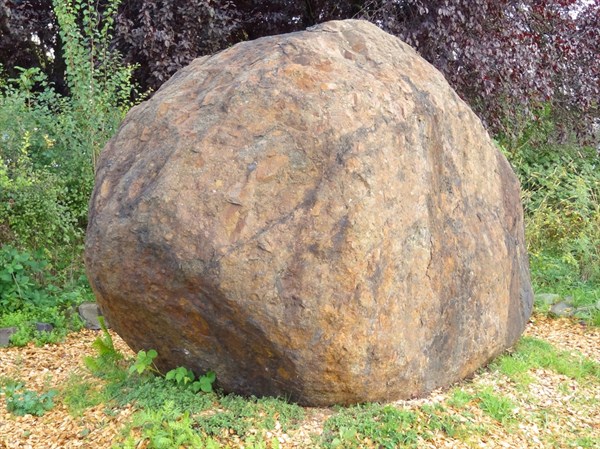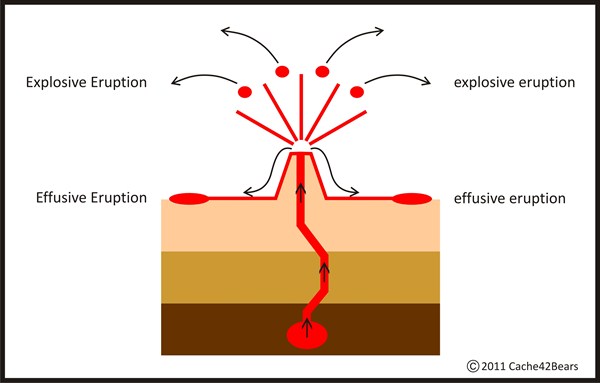[DE] Da "Findlinge" (dies ist definitiv kein "Findling"!) nicht mehr als Earthcache akzeptiert werden, haben wir einen Mini-Multi an dieser interessanten Stelle platziert.
[EN] Since this cache was not accepted as an Earthcache before, we made a little multi-stage-cache at this very interesting place.
This is German, click here for the English version
Vulkanit
Das Vorkommen von sogenannten „Vulkaniten“ ist in der Rheinregion keine Seltenheit. Im Rhein-Sieg-Kreis gibt es etliche Zeugen dieser vulkanischen Tätigkeit vor etwa 350 Millionen Jahren. Viele Funde sind außerdem im Siebengebirge registriert, noch mehr in der nahegelegenen Eifel.
 KERATOPHYR-RUNDBLOCK, ERGUSSGESTEIN
KERATOPHYR-RUNDBLOCK, ERGUSSGESTEIN
Ein Vulkanit wird auch „vulkanisches Gestein“, „Ergussgestein“ oder „Eruptivgestein“ genannt. Es handelt sich um ein Gestein, das durch einen Vulkanausbruch aufgrund der raschen Abkühlung des geschmolzenen Materials an der Erdoberfläche entsteht.
In einer Erdtiefe ab etwa 100 km, in der Temperaturen zwischen 1.000 und 1.300 Grad Celsius herrschen, schmelzen Gesteine zu einer zähen Masse, dem sogenannten Magma. Es sammelt sich in großen, tropfenförmigen Gebilden in 2 bis 50 km Tiefe. Wenn der Druck aus dem Inneren der Erde auf diese Gebilde zu groß wird, steigt das Magma über Spalten in der Erdkruste bis an die Erdoberfläche auf. Magma, das auf diese Weise an die Erdoberfläche gelangt, wird als Lava bezeichnet und tritt aus kraterförmigen Öffnungen in der Erdkruste (den Vulkanen) heraus. Das nennt man „Eruption“ (Ausbruch).
Dabei gibt es zwei unterschiedliche Möglichkeiten (sowie eine Kombination aus beiden):
- Entweder ist die Lava dünnflüssig und tritt relativ ruhig aus dem Förderschlot heraus. Dabei bildet sie kleine Lavafontänen, Lavaströme oder sogar Lavaseen. Solche Lavaströme können weite Strecken zurücklegen, haben dabei keine große zerstörerische Kraft und sind aufgrund ihrer meist langsamen Fließgeschwindigkeit gut einzuschätzen. Man nennt solche Ausbrüche auch effusive Eruptionen (effusiv = lateinisch für "ausgießen").
- Oder die Lava ist zähflüssig und enthält viel Gas, das nicht entweichen kann. Dann kommt es zu sogenannten explosiven Eruptionen, bei denen tonnenschwere Lavabomben aufgrund des hohen Gasdrucks kilometerweit aus dem Vulkan heraus schießen können. Durch die schnelle Abkühlung des zähflüssigen Lavaklumpens oberhalb der Erdoberfläche entstehen sogenannte Vulkaniten, die als verfestigtes Lava auf der Erdoberfläche liegen bleiben (so wie der Vulkanit hier in Sankt Augustin). Explosive Vulkanausbrüche sind schwer einzuschätzen und weisen in der Regel ein großes zerstörerisches Potential auf.

Ein Vulkan kann auch zugleich effusiv und explosiv ausbrechen, was ihn noch gefährlicher macht.
Es gibt heute weltweit ca. 1.500 aktive (d.h. in den letzten 10.000 Jahren ausgebrochene) Vulkane auf der Erdoberfläche. Die Zahl der Vulkane, die sich auf dem Meeresboden befinden, ist unbekannt. Sie wird auf 5.000 - 10.000 geschätzt.
Quelle: Zusammenfassung aus Wikipedia.de und Vulkane.net
So loggt Ihr diesen Cache:
- Messt in mittlerer Höhe den Umfang des Vulkaniten in Sankt Augustin (zu zweit geht das deutlich besser als alleine) und rundet das Ergebnis auf eine volle Meterzahl. Diese Zahl sei U.
(Beispiel: gemessener Umfang = 3,70 m -> U=4)
- Lest Euch die Informationstafel am Vulkanit durch. Dort befindet sich eine Angabe über das Gewicht des Vulkanits in Sank Augustin. Diese Zahl sei G.
(Beispiel: Gewichtsangabe ca. 12 t -> G=12)
- Das Final findet Ihr bei: N 50° 46.(U*G)+111 E 007° 11.U+G+37
- Bitte beachte: Das Final ist zu flach um irgendwelche Tauschobjekte aufzunehmen!
- Wenn Ihr mögt, nehmt ein Foto von Euch vor dem Vulkaniten auf und ladet es in Eurem Log hoch.

Viel Spaß bei der Entdeckungsreise und beim Cachen!
Cache42Bears
Hier folgt die Englische Version, für Deutsch bitte hier klicken.
Vulkanit
The appearance of so called "Vulkanit" is not a rarity in the Rhineland. Around Sankt Augustin there are several stone formations that are in witness for the eruption of volcanic activities 350 million years ago. Further discoveries are in the Siebengebirge (south of Bonn) even more in the Volcanic Eifel (south-east of Bonn).
 KERATOPHYR-RUNDBLOCK, ERGUSSGESTEIN
KERATOPHYR-RUNDBLOCK, ERGUSSGESTEIN
Vulkanit is another name for "volcanic rock", "extrusive rock" or "eruptive rock". It arises from volcanic outbursts due to the sudden cooling down of the melted material from deeper layers of earth after reaching the earth's surface.
Layers of earth 65 miles and deeper with temperatures of 1.800 to 2.400 degrees Fahrenheit generate liquid rock, a viscous mixture, the so called magma. It is gathered in huge magma bubbles 2 to 30 miles under the earth's surface. When the pressure inside these layers grows the magma rises to the surface through gaps in the layers. The magma that reaches the earth's surface pouring through volcanoes is called lava and the process is known as a volcanic eruption.
There are two ways for a volcano to erupt (also a combination of these two is possible):
- Either the inviscid lava pours calmly out of the volcano bearing fountains, flows and lakes. These flows may travel long distances but the disruptive forces are slight due to the calm velocity of flow. These eruptions are called "effusive eruption".
- Or the viscous lava containing a huge ammount of gas impossible to escape causes explosive eruptions. In this case lava bombs of many thousand ponds are projected into the air landing miles away at the surface. Due to the sudden cooling down of the lava the melted material stiffens immediately, bearing the so called "Vulkanit" - like the Vulkanit you can see here in Sankt Augustin. The disruptive force of explosive eruptions is enormously and difficult to predict.

The possible combination of an effusive and an explosive eruption makes the outburst of a volcano unpredictable and really dangerous.
Today about 1.500 active volcanoes above the earth's surface are registered (that means volcanoes that had an eruption within the last 10.000 years). The ammount of active submarine volcanoes is estimated at 5.000 - 10.000.
(Source: Summary of informations at Wikipedia.de and Vulkane.net)
How to log this Cache:
- Determine the circumference of the Vulkanit in Sankt Augustin (at the medium hight of the rock) and round your result to the next fully number of meters. This number is U. (It might be easier to do that by twos.)
(e.g: circumference = 3,70 m -> U=4)
- Have a look at the nearby information panel and find out the weight in tons of the Vulkanit in Sankt Augustin. This number is G.
(e.g.: weight app. 12 t -> G=12)
- Here is the final: N 50° 46.(U*G)+111 E 007° 11.U+G+37
- Please note: The final is too small for trading items!
- We’d be delighted if you’d take a picture of yourself in front of the Vulkanit in addition to your log.

Have fun at your expedition and enjoy caching!
Cache42Bears
Back to TOP / nach oben